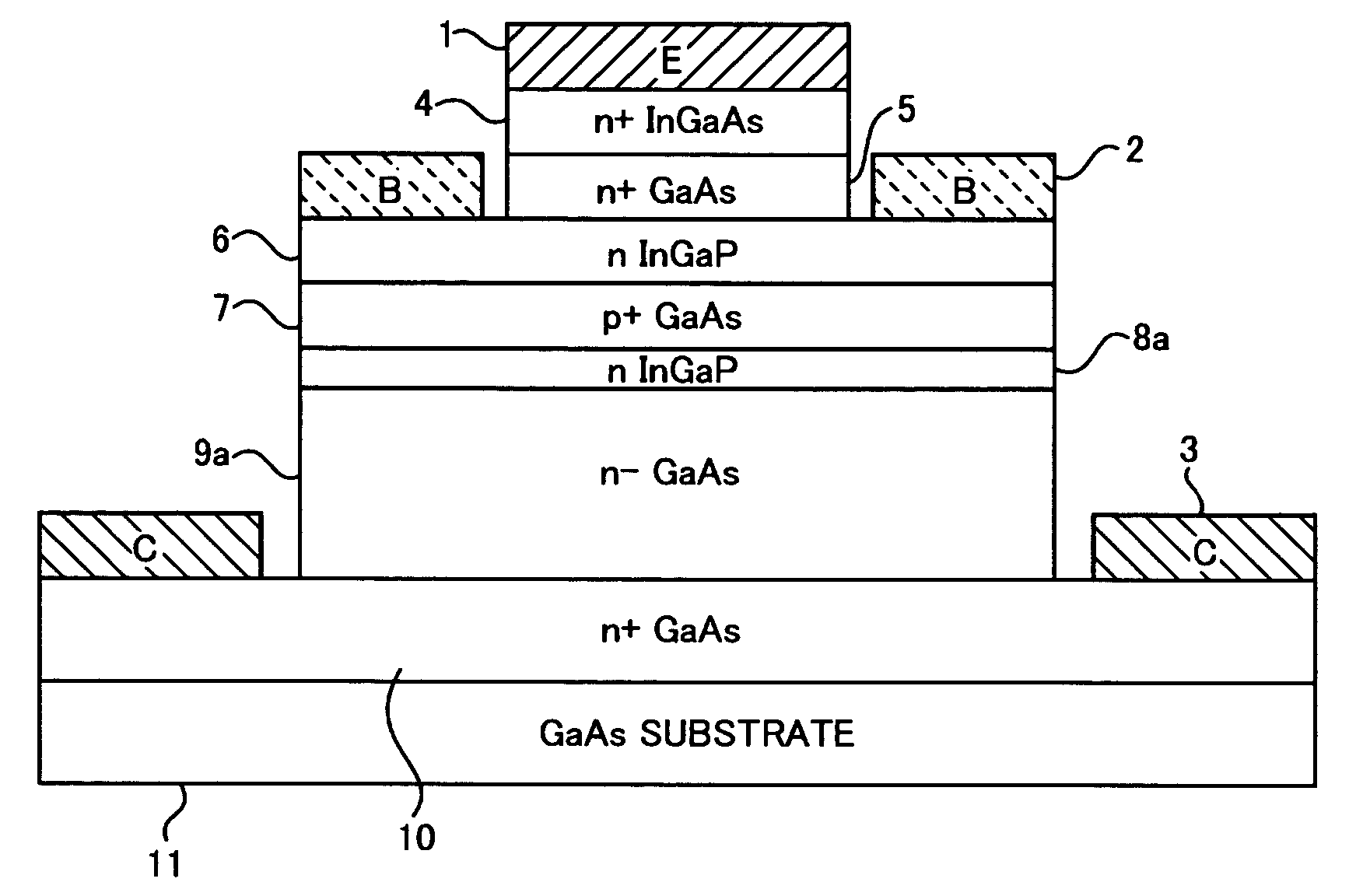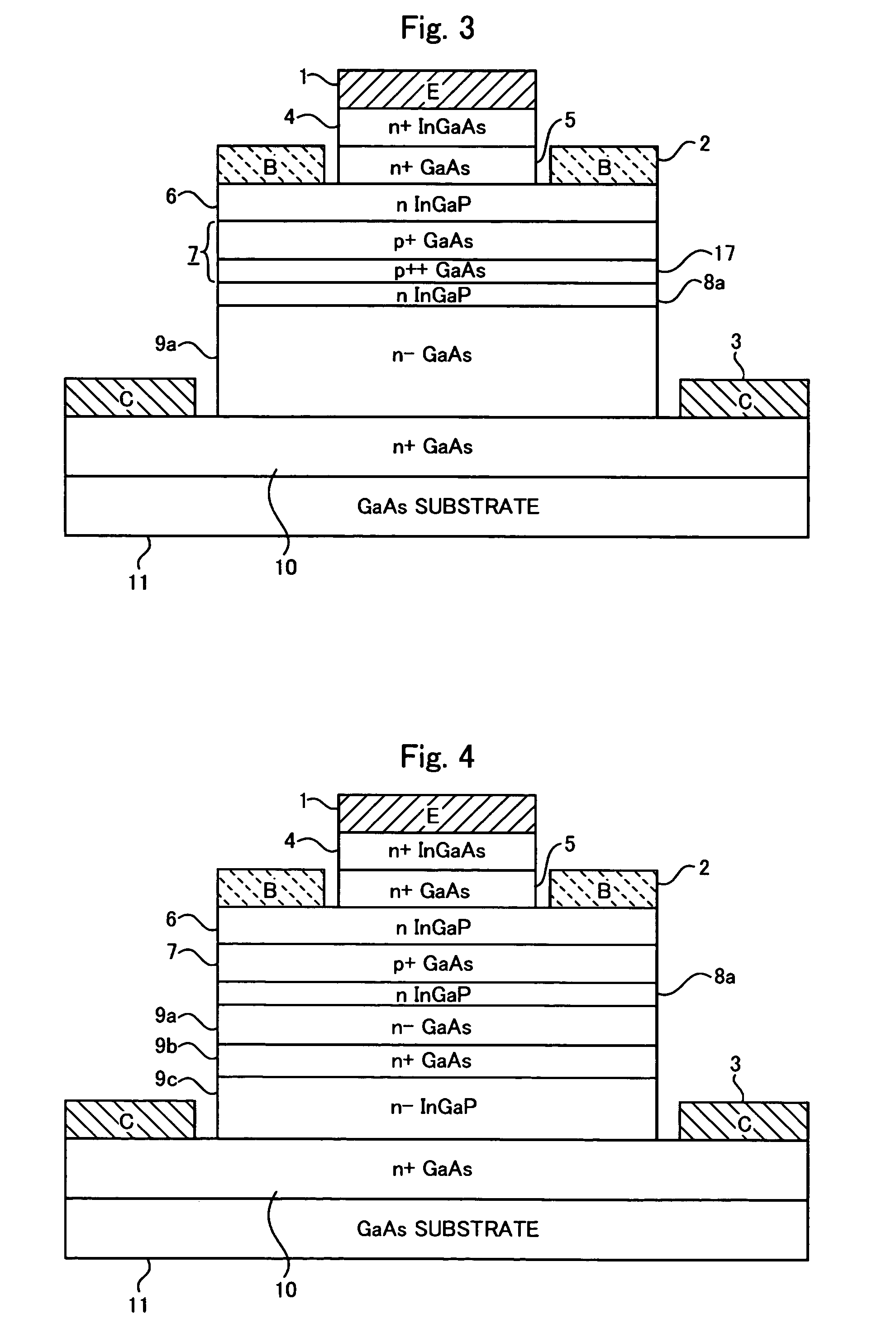Semiconductor device
a technology of bipolar transistors and semiconductors, applied in the direction of semiconductor devices, basic electric elements, electrical equipment, etc., can solve the problems of increased turn-on resistance, increased turn-on resistance when a large current is flowing, and raised turn-on resistance, rather than being lowered, so as to achieve high power-added efficiency, further lowering turn-on resistance, and high power-added efficiency
- Summary
- Abstract
- Description
- Claims
- Application Information
AI Technical Summary
Benefits of technology
Problems solved by technology
Method used
Image
Examples
embodiment 1
[0048] Embodiment 1, based on the first aspect of this invention, is explained in detail referring to FIG. 1 and to FIG. 14 through FIG. 16 illustrating advantageous results of the invention. FIG. 16 shows current-voltage characteristics in Gm mode. The vertical axis plots the collector current density; the horizontal axis plots the layer thickness of the N-type hole barrier thin film layer 8a in FIG. 1 of this invention. The N-type hole barrier thin film layer 8a used in these measurements had a doping concentration of 2×1018 cm−3, and was an ordering-system In0.48Ga0.52P with a band gap of 1.85 eV. Here “ordering-system” denotes growth under grown conditions such that a natural superlattice is formed in the InGaP layer. An ordering-system has a somewhat lower band gap Eg compared with a disordering-system, but has a smaller conduction band discontinuity. As a result, from the standpoint of reducing the turn-on resistance, it is preferable to use ordering-system InGaP as the N-type...
embodiment 2
[0051] Embodiment 2, based on the second aspect, is explained using FIG. 2. In Embodiment 2, an N-type In0.48Ga0.52P layer 5 nm thick, doped with Si to 2×1018 cm−3, is formed as the N-type hole barrier thin film layer 8a on the N-type GaAs collector layer 9a, doped to 5×1015 cm−3. This InGaP layer is ordering-system InGaP with a band gap of 1.85 eV. An 80 nm thick P-type GaAs layer with an acceptor concentration of 4×1019 cm−3 is formed on the N-type hole barrier thin film layer 8a, and P-type δ doping is performed at the interface with the N-type hole barrier thin film layer 8a. The δ-doping sheet concentration of P-type δ-doped region 12 is 1×1012 cm−2. It is seen that the turn-on resistance is reduced, from the 6.1×10−6 Ω-cm2 when a P-type δ-doped region 12 is not formed, to 5.5×10−6 Ω-cm2 when a P-type δ-doped region 12 is formed.
embodiment 3
[0052] Embodiment 3, based on the second aspect, is explained using FIG. 3. A difference with the structure shown in FIG. 2 is the insertion, in place of the P-type δ-doped region 12, of a P++ GaAs layer 17. As the P++ GaAs layer 17, GaAs 5 nm thick, doped to 4.2×1019 cm−3, is used. Because other regions of the base layer 7 are doped to 4×1019 cm−3, the increase in the acceptor concentration due to introduction of the P++ GaAs layer 17 is 1×1012 cm−3. The turn-on resistance at this time is 5.5×10−6 Ω-cm2, so that a low value equivalent to that of Embodiment 2 is obtained.
[0053] (Third Aspect)
[0054] In the first and second aspects of the invention, the N-type hole barrier thin film layer 8a can be configured as an undoped hole barrier thin film layer. This configuration is explained as a third aspect of the invention. Explanation of portions of the configuration which are similar to those of the first and second aspects is omitted. In the third aspect, the N-type hole barrier thin ...
PUM
 Login to View More
Login to View More Abstract
Description
Claims
Application Information
 Login to View More
Login to View More - R&D
- Intellectual Property
- Life Sciences
- Materials
- Tech Scout
- Unparalleled Data Quality
- Higher Quality Content
- 60% Fewer Hallucinations
Browse by: Latest US Patents, China's latest patents, Technical Efficacy Thesaurus, Application Domain, Technology Topic, Popular Technical Reports.
© 2025 PatSnap. All rights reserved.Legal|Privacy policy|Modern Slavery Act Transparency Statement|Sitemap|About US| Contact US: help@patsnap.com



